The global wireless HDMI transmitter and receiver market is valued at USD 1,288.9 million in 2025. It is slated to reach USD 1,963.7 million by 2035, recording an absolute increase of USD 674.8 million over the forecast period. This translates into a total growth of 52.3%, with the wireless HDMI transmitter and receiver market forecast to expand at a compound annual growth rate (CAGR) of 4.3% between 2025 and 2035. The overall market size is expected to grow by approximately 1.52 times during the same period, supported by increasing demand for wireless video transmission solutions in professional broadcast and filmmaking applications, growing adoption of wireless HDMI technology in live event production and content creation workflows, and rising emphasis on cable-free production environments across diverse entertainment, corporate, and educational applications.
Between 2025 and 2030, the wireless HDMI transmitter and receiver market is projected to expand from USD 1,288.9 million to USD 1,590.9 million, resulting in a value increase of USD 302.0 million, which represents 44.8% of the total forecast growth for the decade. This phase of development will be shaped by increasing production of high-quality video content for streaming platforms, rising demand for professional-grade wireless transmission systems in broadcast studios and live events, and growing emphasis on mobility and flexibility in video production workflows. Film production companies and broadcast operators are expanding their wireless HDMI capabilities to address the growing demand for reliable and high-performance solutions that ensure signal quality and operational flexibility.
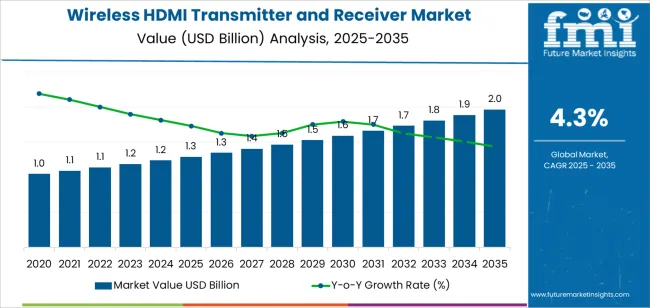
From 2030 to 2035, the wireless HDMI transmitter and receiver market is forecast to grow from USD 1,590.9 million to USD 1,963.7 million, adding another USD 372.8 million, which constitutes 55.2% of the overall ten-year expansion. This period is expected to be characterized by the expansion of 4K and 8K wireless transmission technologies and ultra-low latency systems, the development of AI-powered signal optimization and interference management solutions, and the growth of specialized applications for virtual production environments and remote broadcast operations. The growing adoption of next-generation video formats and immersive content production will drive demand for wireless HDMI systems with enhanced bandwidth and transmission reliability features.
Between 2020 and 2025, the wireless HDMI transmitter and receiver market experienced steady growth, driven by increasing demand for professional video production equipment and growing recognition of wireless transmission systems as essential tools for enhancing production efficiency and creative flexibility in diverse broadcast and filmmaking applications. The wireless HDMI transmitter and receiver market developed as cinematographers and broadcast engineers recognized the potential for wireless HDMI technology to eliminate cable constraints, improve camera mobility, and support collaborative workflows while meeting stringent quality requirements. Technological advancement in wireless protocols and signal compression began emphasizing the critical importance of maintaining video fidelity and transmission stability in challenging production environments.
| Metric | Value |
|---|---|
| Estimated Value in (2025E) | USD 1,288.9 million |
| Forecast Value in (2035F) | USD 1,963.7 million |
| Forecast CAGR (2025 to 2035) | 4.3% |
Market expansion is being supported by the increasing global demand for professional video production equipment driven by streaming content growth and live event proliferation, alongside the corresponding need for advanced wireless transmission systems that can enhance production flexibility, enable innovative camera movements, and maintain signal integrity across various film production, broadcasting, corporate video, and live event applications. Modern content creators and broadcast professionals are increasingly focused on implementing wireless HDMI solutions that can eliminate cable limitations, improve production efficiency, and provide consistent performance in demanding production conditions.
The growing emphasis on production quality and workflow efficiency is driving demand for wireless HDMI systems that can support high-resolution video transmission, enable multi-camera setups, and ensure comprehensive signal reliability. Equipment manufacturers' preference for transmission solutions that combine video quality with operational flexibility and interference resistance is creating opportunities for innovative wireless HDMI implementations. The rising influence of streaming platforms and virtual production technologies is also contributing to increased adoption of wireless HDMI systems that can provide superior transmission capabilities without compromising video quality or operational reliability.
The wireless HDMI transmitter and receiver market is segmented by resolution type, application, and region. By resolution type, the wireless HDMI transmitter and receiver market is divided into 1080P devices, 4K and 8K devices, and others. Based on application, the wireless HDMI transmitter and receiver market is categorized into film industry, broadcasting industry, and others. Regionally, the wireless HDMI transmitter and receiver market is divided into East Asia, Europe, North America, South Asia, Latin America, Middle East & Africa, and Eastern Europe.
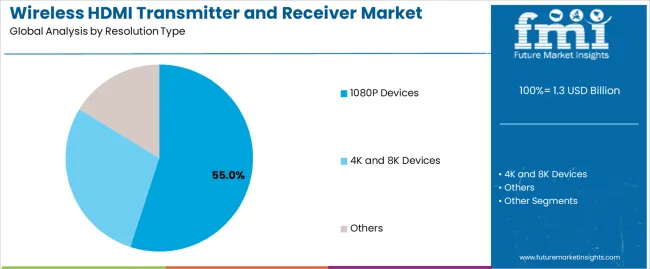
The 1080P devices segment is projected to maintain its leading position with 55% market share in the wireless HDMI transmitter and receiver market in 2025, reaffirming its role as the preferred resolution category for professional video production and broadcast transmission applications. Film production teams and broadcast operators increasingly utilize 1080P wireless HDMI systems for their optimal balance of video quality, transmission reliability, and proven effectiveness in delivering broadcast-grade signals while maintaining cost-effectiveness. 1080P technology's proven effectiveness and widespread adoption directly address the industry requirements for dependable wireless transmission and efficient production workflows across diverse broadcast platforms and production categories.
This resolution segment forms the foundation of modern wireless video transmission, as it represents the technology with the greatest contribution to production flexibility and established performance record across multiple broadcast applications and production environments. Media industry investments in professional video equipment continue to strengthen adoption among content creators and broadcast facilities. With budget pressures requiring cost-effective solutions and proven reliability, 1080P wireless HDMI systems align with both quality objectives and economic requirements, making them the central component of comprehensive production infrastructure strategies.
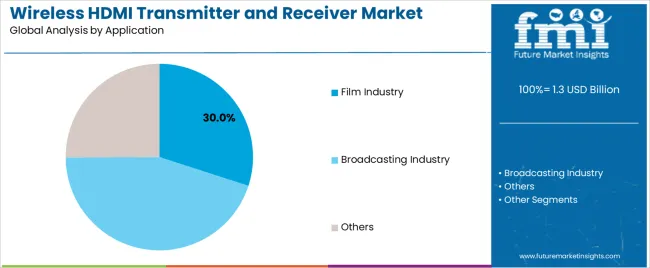
The film industry application segment is projected to represent 30% share of wireless HDMI transmitter and receiver demand in 2025, underscoring its critical role as the primary driver for wireless HDMI adoption across feature film production, commercial filming, and documentary projects. Film production professionals prefer wireless HDMI systems for video monitoring due to their exceptional mobility benefits, production efficiency advantages, and ability to enable creative camera movements while supporting director monitoring and collaborative viewing. Positioned as essential equipment for modern filmmaking operations, wireless HDMI systems offer both technical advantages and creative benefits.
The segment is supported by continuous innovation in wireless transmission technology and the growing availability of advanced systems that enable superior video quality with enhanced transmission range and reduced latency requirements. Additionally, film equipment manufacturers are investing in comprehensive product development programs to support increasingly complex production demands and filmmaker requirements for reliable wireless monitoring solutions. As content production accelerates and production techniques evolve, the film industry application will continue to dominate the wireless HDMI transmitter and receiver market while supporting advanced wireless utilization and production quality optimization strategies.
The wireless HDMI transmitter and receiver market is advancing steadily due to increasing demand for cable-free production solutions driven by streaming content expansion and growing adoption of mobile camera techniques that require specialized transmission systems providing enhanced operational flexibility and production efficiency benefits across diverse film production, broadcasting, live event, and corporate video applications. However, the wireless HDMI transmitter and receiver market faces challenges, including signal interference in congested wireless environments and spectrum limitations, competition from alternative monitoring solutions and wired systems, and technical constraints related to latency requirements and bandwidth availability. Innovation in wireless protocols and signal processing technologies continues to influence product development and market expansion patterns.
The growing production of streaming content is driving demand for professional video equipment that addresses quality requirements including high-resolution transmission, low-latency monitoring, and multi-camera coordination capabilities. Modern content production requires advanced wireless HDMI solutions that deliver superior performance across multiple parameters while maintaining transmission reliability and production efficiency. Production equipment suppliers are increasingly recognizing the competitive advantages of wireless HDMI integration for content quality enhancement and production differentiation, creating opportunities for innovative transmission systems specifically developed for next-generation streaming applications.
Modern film production operations are incorporating virtual production environments and LED volume stages to enhance creative capabilities, support real-time compositing, and address comprehensive production requirements through optimized wireless monitoring and signal distribution. Leading equipment manufacturers are developing specialized wireless systems for virtual production applications, implementing low-latency transmission protocols, and advancing synchronization technologies that improve production flexibility and technical integration. These technologies improve production capabilities while enabling new creative opportunities, including real-time visual effects integration, interactive lighting control, and collaborative production workflows. Advanced wireless integration also allows production teams to support comprehensive technical objectives and creative differentiation beyond traditional filming methods.
The expansion of ultra-high-definition content production, advanced camera technologies, and viewer quality expectations is driving demand for wireless HDMI systems capable of 4K and 8K transmission with precisely engineered compression algorithms and exceptional signal integrity. These advanced applications require specialized transmission systems with optimized bandwidth utilization that address quality requirements, creating premium market segments with differentiated value propositions. Manufacturers are investing in advanced development capabilities and compression technologies to serve emerging high-resolution applications while supporting innovation in professional video production and broadcast industries.
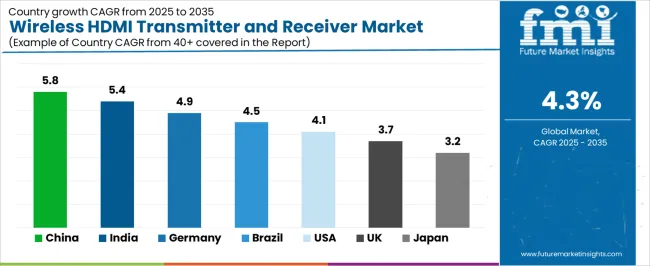
| Country | CAGR (2025-2035) |
|---|---|
| China | 5.8% |
| India | 5.4% |
| Germany | 4.9% |
| Brazil | 4.5% |
| United States | 4.1% |
| United Kingdom | 3.7% |
| Japan | 3.2% |
The wireless HDMI transmitter and receiver market is experiencing solid growth globally, with China leading at a 5.8% CAGR through 2035, driven by expanding film and television production capacity, growing live streaming industry, and increasing adoption of professional video equipment in content creation sector. India follows at 5.4%, supported by rapidly growing entertainment industry, expanding regional film production, and increasing investment in broadcast infrastructure and streaming platforms. Germany shows growth at 4.9%, emphasizing broadcast technology innovation, professional video production excellence, and advanced event technology infrastructure. Brazil demonstrates 4.5% growth, supported by expanding entertainment industry, growing broadcast market, and increasing production of original content for streaming platforms. The United States records 4.1%, focusing on Hollywood production infrastructure, broadcast network modernization, and corporate video production expansion. The United Kingdom exhibits 3.7% growth, emphasizing broadcast innovation, film production facilities, and live event technology deployment. Japan shows 3.2% growth, supported by broadcast technology leadership and professional video equipment adoption.
The report covers an in-depth analysis of 20 countries top-performing countries are highlighted below.
Revenue from wireless HDMI transmitters and receivers in China is projected to exhibit exceptional growth with a CAGR of 5.8% through 2035, driven by expanding film and television production capacity and rapidly growing live streaming industry supported by government cultural development initiatives and digital entertainment policies. The country's massive content production sector transformation and increasing investment in professional video technologies are creating substantial demand for wireless HDMI solutions. Major equipment manufacturers and production companies are establishing comprehensive wireless transmission capabilities to serve both domestic markets and international productions.
Revenue from wireless HDMI transmitters and receivers in India is expanding at a CAGR of 5.4%, supported by the country's rapidly growing entertainment industry, expanding regional film production sectors, and increasing demand for professional broadcast equipment driven by streaming platform investments and content production requirements. The country's comprehensive media industry development and growing technical sophistication are driving wireless HDMI adoption throughout diverse production sectors. Leading equipment distributors and international manufacturers are establishing distribution and service facilities to address growing domestic demand.
Revenue from wireless HDMI transmitters and receivers in Germany is expanding at a CAGR of 4.9%, supported by the country's leadership in broadcast technology innovation, professional video production excellence, and strong emphasis on advanced event technology infrastructure. The nation's technical sophistication and quality standards are driving wireless HDMI capabilities throughout broadcast and production sectors. Leading equipment manufacturers and technology suppliers are investing extensively in advanced transmission systems and specialized applications.
Revenue from wireless HDMI transmitters and receivers in Brazil is expanding at a CAGR of 4.5%, supported by the country's expanding entertainment industry, growing broadcast market, and increasing production of original content for domestic and international streaming platforms. The nation's comprehensive media sector development and production infrastructure investments are driving demand for professional wireless transmission solutions. Equipment distributors and production service providers are investing in technology capabilities to serve growing film and broadcast sectors.
Revenue from wireless HDMI transmitters and receivers in the United States is expanding at a CAGR of 4.1%, supported by the country's Hollywood production infrastructure, established broadcast network operations, and growing emphasis on corporate video production and streaming content creation. The nation's comprehensive entertainment industry and technical excellence are driving demand for advanced wireless HDMI solutions. Equipment manufacturers and production service companies are investing in technology development and distribution capabilities to serve diverse production markets.
Revenue from wireless HDMI transmitters and receivers in the United Kingdom is expanding at a CAGR of 3.7%, driven by the country's broadcast innovation leadership, established film production facilities, and advanced live event technology deployment. The nation's media industry excellence and technical standards are supporting investment in professional wireless transmission technologies. Equipment suppliers and production service providers are establishing capabilities for equipment support and technical training programs.
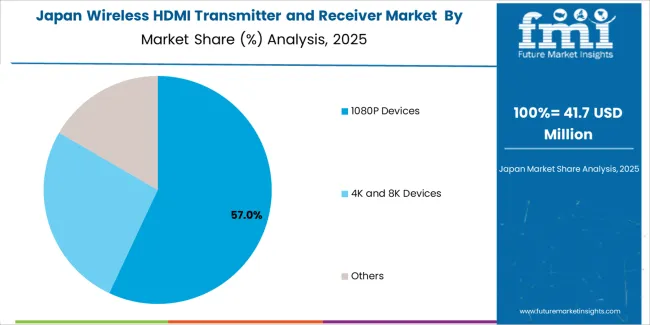
Revenue from wireless HDMI transmitters and receivers in Japan is expanding at a CAGR of 3.2%, supported by the country's broadcast technology leadership, professional video equipment sophistication, and strong emphasis on technical quality and innovation. Japan's broadcast standards and manufacturing excellence are driving demand for advanced wireless transmission equipment. Equipment manufacturers and broadcast organizations are investing in next-generation transmission technologies.

The wireless HDMI transmitter and receiver market in Europe is projected to grow from USD 460.1 million in 2025 to USD 681.0 million by 2035, registering a CAGR of 4.0% over the forecast period. Germany is expected to maintain leadership with a 24.3% market share in 2025, moderating to 24.0% by 2035, supported by broadcast technology excellence, professional production infrastructure, and strong equipment manufacturing capabilities.
The United Kingdom follows with 19.7% in 2025, projected at 19.5% by 2035, driven by film production facilities, broadcast innovation, and live event technology deployment. France holds 16.2% in 2025, rising to 16.4% by 2035 on the back of film production heritage and broadcast modernization programs. Italy commands 12.8% in 2025, increasing to 13.0% by 2035, while Spain accounts for 9.5% in 2025, reaching 9.7% by 2035 aided by expanding production facilities and broadcast infrastructure. Netherlands maintains 6.3% in 2025, up to 6.5% by 2035 due to broadcast innovation and event technology leadership. The Rest of Europe region, including Nordic countries, Eastern Europe, and other markets, is anticipated to hold 11.2% in 2025 and 10.9% by 2035, reflecting steady development in broadcast modernization, film production expansion, and live event technology adoption.
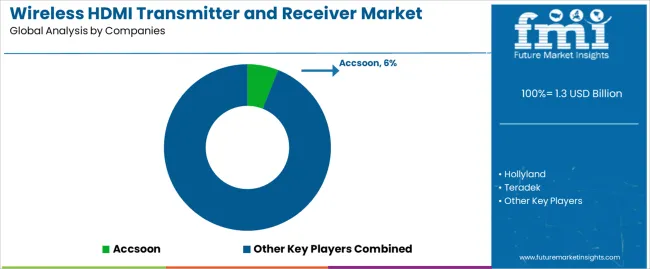
The wireless HDMI transmitter and receiver market is characterized by competition among specialized video transmission equipment manufacturers, broadcast technology suppliers, and professional video equipment producers. Companies are investing in transmission technology development, latency reduction innovation, product range expansion, and application-specific system optimization to deliver high-performance, reliable, and cost-effective wireless HDMI solutions. Innovation in wireless protocols, signal compression algorithms, and interference management technologies is central to strengthening market position and competitive advantage.
Accsoon leads the wireless HDMI transmitter and receiver market with comprehensive wireless transmission solutions with a focus on affordable professional systems, innovative features, and reliable performance across diverse film production and broadcast applications. Hollyland provides wireless video transmission equipment with emphasis on cost-effectiveness and feature-rich designs for content creators. Teradek delivers premium wireless transmission systems with focus on broadcast reliability and professional production requirements. VidOvation offers specialized wireless solutions with emphasis on long-range transmission and interference resistance. Vaxis provides innovative wireless systems with comprehensive feature sets for professional applications. Boxx specializes in compact wireless transmission solutions for camera operators. Lilliput focuses on monitoring solutions with integrated wireless capabilities. Z CAM provides camera systems with wireless transmission integration. Zhiyun-Tech offers gimbal-integrated wireless solutions for mobile filmmaking. FeelWorld specializes in monitor products with wireless connectivity. DJI delivers comprehensive production equipment with wireless transmission capabilities. CVW provides broadcast-quality wireless systems. Swit focuses on professional video equipment with wireless solutions. Dynacore offers power and wireless solutions for production applications. LAIZE specializes in wireless transmission systems. SKEOM provides professional wireless equipment. MANI delivers broadcast wireless solutions. IDX offers power and wireless system integration. ARRI provides premium cinema equipment with wireless capabilities. ST video-film focuses on professional transmission systems. Brocade Smart Space Technology delivers innovative wireless solutions.
Wireless HDMI transmitters and receivers represent a specialized professional video equipment segment within content production and broadcast applications, projected to grow from USD 1,288.9 million in 2025 to USD 1,963.7 million by 2035 at a 4.3% CAGR. These advanced transmission systems primarily serve video monitoring and signal distribution requirements in film production, television broadcasting, live event production, and corporate video applications where cable-free operation, production flexibility, and signal reliability are essential. Market expansion is driven by increasing streaming content production, growing professional video equipment adoption, expanding live event broadcasting, and rising demand for flexible production solutions across diverse entertainment and media sectors.
How Industrial Regulators Could Strengthen Wireless Standards and Spectrum Management?
How Industry Associations Could Advance Technical Standards and Professional Development?
How Wireless HDMI Manufacturers Could Drive Innovation and Market Leadership?
How End-User Industries Could Optimize Wireless Technology and Production Workflows?
How Research Institutions Could Enable Wireless Technology Advancement?
How Investors and Financial Enablers Could Support Market Growth and Innovation?
| Items | Values |
|---|---|
| Quantitative Units (2025) | USD 1,288.9 million |
| Resolution Type | 1080P Devices, 4K and 8K Devices, Others |
| Application | Film Industry, Broadcasting Industry, Others |
| Regions Covered | East Asia, Europe, North America, South Asia, Latin America, Middle East & Africa, Eastern Europe |
| Countries Covered | China, India, Germany, Brazil, United States, United Kingdom, Japan, and 20 countries |
| Key Companies Profiled | Accsoon, Hollyland, Teradek, VidOvation, Vaxis, Boxx |
| Additional Attributes | Dollar sales by resolution type and application category, regional demand trends, competitive landscape, technological advancements in wireless transmission protocols, latency reduction innovation, signal compression development, and production workflow optimization |
The global wireless HDMI transmitter and receiver market is estimated to be valued at USD 1.3 billion in 2025.
The market size for the wireless HDMI transmitter and receiver market is projected to reach USD 2.0 billion by 2035.
The wireless HDMI transmitter and receiver market is expected to grow at a 4.3% CAGR between 2025 and 2035.
The key product types in wireless HDMI transmitter and receiver market are 1080p devices, 4k and 8k devices and others.
In terms of application, film industry segment to command 30.0% share in the wireless HDMI transmitter and receiver market in 2025.






Full Research Suite comprises of:
Market outlook & trends analysis
Interviews & case studies
Strategic recommendations
Vendor profiles & capabilities analysis
5-year forecasts
8 regions and 60+ country-level data splits
Market segment data splits
12 months of continuous data updates
DELIVERED AS:
PDF EXCEL ONLINE
Wireless Access Point Market Size and Share Forecast Outlook 2025 to 2035
Wireless Video - 2.4/5GHz Market Size and Share Forecast Outlook 2025 to 2035
Wireless Polysomnography Market Size and Share Forecast Outlook 2025 to 2035
Wireless Audio Devices Market Size and Share Forecast Outlook 2025 to 2035
Wireless Communication Technologies In Healthcare Market Size and Share Forecast Outlook 2025 to 2035
Wireless Mesh Network Market Size and Share Forecast Outlook 2025 to 2035
Wireless Sensor Tags Market Size and Share Forecast Outlook 2025 to 2035
Wireless Sensor Network Market Size and Share Forecast Outlook 2025 to 2035
Wireless Power Transmission Market Size and Share Forecast Outlook 2025 to 2035
Wireless Home Security Camera Market Size and Share Forecast Outlook 2025 to 2035
Wireless Testing Market Size and Share Forecast Outlook 2025 to 2035
Wireless Power Bank Market Size and Share Forecast Outlook 2025 to 2035
Wireless Battery Monitoring System Market Size and Share Forecast Outlook 2025 to 2035
Wireless Printer Market Size and Share Forecast Outlook 2025 to 2035
Wireless Headphones Market Size and Share Forecast Outlook 2025 to 2035
Wireless Sensors Market Size and Share Forecast Outlook 2025 to 2035
Wireless Display Market Size and Share Forecast Outlook 2025 to 2035
Wireless Paging Systems Market Size and Share Forecast Outlook 2025 to 2035
Wireless Patient Monitoring Market Size and Share Forecast Outlook 2025 to 2035
Wireless Earphone Market Size and Share Forecast Outlook 2025 to 2035

Thank you!
You will receive an email from our Business Development Manager. Please be sure to check your SPAM/JUNK folder too.
Chat With
MaRIA